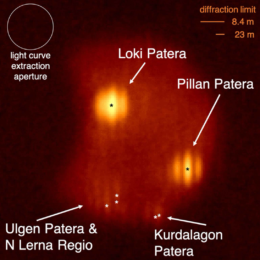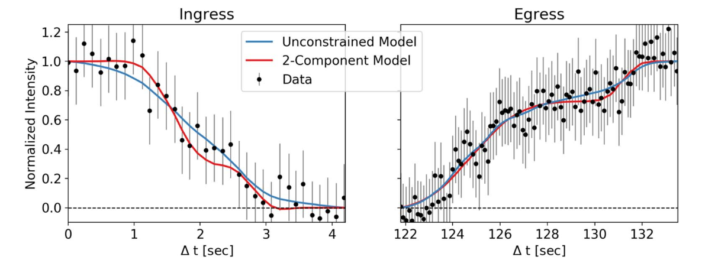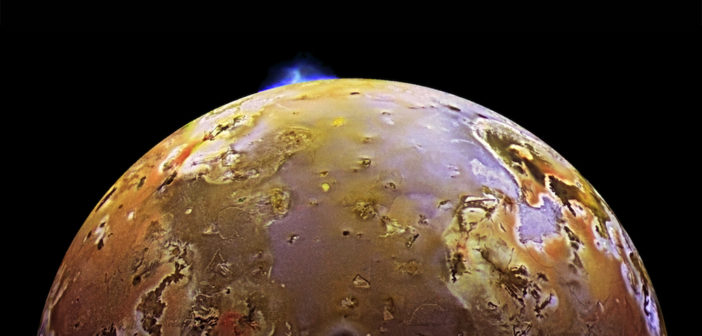What’s going on under the surface of the most volcanically active body in the solar system, and what’s driving its massive plumes? Observations of hot spots on Jupiter’s moon Io reveal more detail than ever before and may help us get closer to solving the mysteries of this volcanic world.
Tidal Heating
Volcanoes and geological activity are not unique to Earth but are common in the solar system. One of the most volcanically active bodies in the solar system is Jupiter’s moon Io. Io gets stretched and squeezed as it circles the gas giant. Just as Earth’s oceans react to the pull of the Moon, Io’s crust reacts to the pull of Jupiter in a process called tidal heating. The surface bulges up and down by as much as 100 meters during its rotation, and this tidal heating forms the dynamic surface of Io.

An infrared image of the beginning of the occultation of Io by Europa. The dark area on the left is Europa and the hotspot regions are the pateras, which are broad, bowl-shaped volcanic craters. [de Kleer et al. 2021]
Fine-Detailing the Surface
In order to study the volcanic processes of Io in detail, very high spatial resolution is needed. Until now, astronomers have only been able to distinguish one volcano from the other. A team led by Katherine de Kleer at the California Institute of Technology looked at four volcanoes on Io’s surface using a new method and was able to map the moon’s volcanic emission in more detail than ever before.
Occultation Localization
The team observed Io with the Large Binocular Telescope Interferometer, located in southeastern Arizona, during an occultation by Jupiter’s other moon, Europa. As Europa passed in front of Io, de Kleer’s team monitored the volcanic moon’s brightness to pinpoint the moment Europa obscured each hot spot. A step-like pattern in the light curve corresponds to the disappearances and reappearances of the hot spots, which can pinpoint the locations of emission.

The motion of Europa (dark shadow) across Io’s face during the occultation observed by de Kleer et al., with the volcanoes of interest labeled on Io’s surface. [de Kleer et al. 2021]

The light curve of Kurdalagon Patera during the occultation with the best fit models. The evidence for the two emitting areas is shown in the beginning (∆t = 122-126) and end (∆t = 131-133) of the graph. [de Kleer et al. 2021]
Citation
“Resolving Io’s Volcanoes from a Mutual Event Observation at the Large Binocular Telescope,” K. de Kleer et al 2021 PSJ 2 227. doi:10.3847/PSJ/ac28fe

